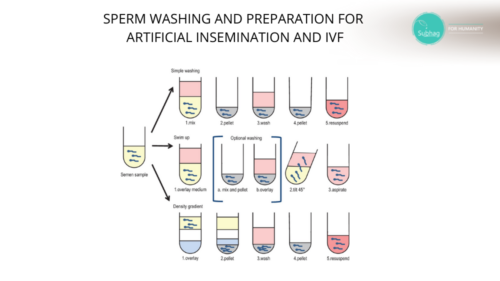Infertility is one of the major issues that we are facing today. There are many different ideas and solutions that we are working to solve the problem.
There are some techniques and procedures using which we can try to overcome this issue and the IUI treatment success rate is the highest among all. But in order to get these procedures done right, you need to have high-quality sperm.
There are multiple options to get the high-quality sperm out of the male; However, in order to get the top quality out of all the available samples, we can surely use the sperm washing technique. Sperm washing is necessary in order to improve the IUI treatment success rate.
Let’s Understand Different Techniques Of Sperm Washing And How It Can Improve IUI Treatment Success Rate
How Is The Sperm Sample To Improved The IUI Treatment Success Rate Prepared?
IUI is a reasonably easy procedure that couples who are having trouble conceiving a child undergo. Intrauterine Insemination, or IUI, is a procedure that involves injecting sperm cells directly into the uterus in order to maximize the chances of fertilization. It is a painless procedure performed without the use of anesthesia.
The process entails concentrating the most motile sperm from the sperm cells before injecting them into the uterus. The goal is to enhance the number of motile sperm cells reaching the eggs and, as a result, the chances of improvising the IUI treatment success rate.

Collection Of The Sperm Sample
The sperm sample should be taken after a period of two to five days of sexual abstinence, not less or more. This is done to guarantee that the sperm count is as high as possible, as well as the mobility and health of the cells produced.
The sample was collected and left to liquefy for around 30 minutes in a sterile wide-mouth container. Once the sample has liquefied, processing begins and should be completed within 90 minutes of collection.
What Is Sperm Washing And How It Can Help To Improve The IUI Treatment Success Rate?
A sperm sample is obtained and washed before the IUI procedure. The sperm wash comprises removing excess fluid, removing dead sperms, weak sperms, germs, debris, and prostaglandins that might cause uterine cramps, and concentrating the most motile sperms so that a greater number of motile sperm cells enter the uterus.
The first step in preparing a sperm sample for IUI is to wash it. The sperm cells are separated from the seminal fluid in this procedure.
This process increases the odds of sperm reaching the fallopian tubes by enhancing its fertilizing capacity, in addition to eliminating contaminants. As a result, it can help couples who are experiencing infertility or have immune system issues. This means an improved IUI treatment success rate.
Techniques For Sperm Washing And Preparation For Artificial Insemination And IVF
Sperm washing is a type of sperm preparation that is required prior to intrauterine insemination (IVF) because it removes toxins from the sperm that could induce negative uterine reactions.
Sperm is isolated from seminal fluid during the sperm washing procedure. In cases of immune system problems, male-factor infertility, or unexplained infertility, this technique improves the fertilizing potential of the sperm.
Prior to collecting sperm, it is recommended that you abstain from sexual activity for at least 2 days but no longer than 5 days. Specimens can be gathered at the facility or at home, as long as the trip to the facility does not take more than an hour.
Dry masturbation should be used to collect specimens in sterile wide-mouth containers (no lubricants). Containers with the label urine specimen cups are available at the laboratory and at medicine stores. The container must be kept upright with the lid properly fastened once the sample has been collected.
If you’re making the specimen at home, make sure it’s kept at body temperature. During chilly weather, the container should be placed in an inner pocket.
Antibiotic allergies should be disclosed prior to sperm washing. These are important factors to be considered as they can impact the IUI treatment success rate.
Prior to intrauterine insemination, the seminal plasma, and any cryoprotectant, if any, are removed from the specimen.
- Basic Sperm Wash
- Premium Wash
- Swim-up Technique
Prior to starting intrauterine insemination therapy, sperm washing can be done on a single specimen. A trial wash is used to identify which sperm washing method will produce the greatest results.
Simple Sperm Wash
Dilution and centrifugation are used in this method. To the ejaculate is added a sperm wash solution including antibiotics and protein supplements. The seminal fluid is removed from the sample after repeated centrifugation, and the sperm cells are concentrated for insemination. It takes 20 to 40 minutes to complete this process.

In a test tube, sperm is diluted with an antibiotic and protein supplement solution. The sample is subsequently placed in a centrifuge, which spins at incredibly high speeds. Sperm cells descend to the bottom of the test tube as the sperm mixture is spun, resulting in a dense, highly active sperm mass. After that, the sperm can be taken out of the test tube and used in IUI. It takes roughly 20 to 40 minutes to perform a simple sperm wash.
Advantages
- It is the easiest sperm preparation method.
- Requires the least amount of media and is less expensive.
Disadvantages
- The final preparation retains not only the dead, defective spermatozoa but also all the components in semen that may be pelleted by centrifugation.
- The sperm chromatin and plasma membrane in the concentrated sperm-rich pellet are extremely vulnerable to oxidative damage.
- There’s a potential that anti-sperm antibodies will develop after an IUI operation.
Premium Wash Or The Method Based On The Specific Density
This method uses density gradient centrifugation to isolate and purify the motile sperm in order to obtain a sperm sample with motility of at least 90%, depending on the initial quality of the sample.
Different concentrations of isolate (extremely dense fluid) are layered in a test tube in ascending order of density (the heaviest layer at the bottom).
When a semen sample is placed upon the upper-most isolate layer and centrifuged, any debris, round cells, non-motile, and poor quality sperm remain in the top layers.
Only the motile sperm are able to get through to the bottom layer and are then concentrated for use in artificial insemination. This procedure takes 1 hour. The premium sperm wash technique is excellent for fresh or frozen sperm and can help assess male factor fertility.
The density gradient sperm wash is one of the most popular sperm washing methods. This is because it also works to separate dead sperm cells, white blood cells, and other waste products from the sperm.
A test tube is filled with multiple layers of liquids of different densities. Semen is then placed on the top layer of liquid and the test tube is spun in a centrifuge.
After it is spun, active, healthy sperm will make their way to the very bottom layer of liquid in the test tube, while debris and dead sperm will get caught in the top two layers. These layers can be siphoned off in order to remove the active sperm from the test tube. This sperm is then used in the IUI procedure.
Density gradient sperm washes take approximately 60 minutes.

The density gradient centrifugation (DGC) method segregates spermatozoa based on their specific gravity along a column of the gradient at their isopycnic point when applied with a centrifugal force.
The gradient can be continuous or discontinuous. A mature, morphologically normal sperm has a specific density of 1.12 g/ml whereas the specific density of immature or abnormal or low sperm count is much less than that.
Centrifugation along with the routinely used silane-coated silica particles of the following 40% and 80% gradient (1.06 and 1.10 g/ml respectively) only allows the mature, morphologically normal spermatozoa to penetrate the lowest layer.
Advantages
- This method segregates spermatozoa based on functional maturity, DNA integrity, and morphology.
- It also can be used to remove bacteria, debris, leukocytes, viruses, etc.
- Gives a good yield for Oligoasthenoteratozoospermic samples (OATs).
- It requires less time than a swim-up method.
Disadvantages
- The yield is low when compared to swim up.
- The centrifugation force is high and applied 2-3 times increasing the chances of iatrogenic damage.
- Costly method.
- To get the best yield, it is advisable to combine DGC with SU.
Swim-up Technique Or Sperm Migration Based Methods
This technique uses sperm self-migration to obtain a sperm sample with motility of at least 90%, depending on the initial quality of the sample.
A layer of fresh media is gently added to the semen sample in such a way that most of the motile sperm will swim out of the sample and upward into the added media.
These harvested motile sperm are subsequently used for insemination. This procedure takes 2 hours.
Oligozoospermia men (men with low sperm counts), men with poorly motile sperm as well as men with male-factor infertility are not suitable candidates for this technique. Their sperm will have difficulty swimming up out of the pellet into the nutrient medium.
The swim-up technique is rapidly becoming more and more popular throughout American fertility clinics. semen is placed in a culture dish with a layer of media culture.
Sperm are attracted to this culture and will swim up to it. As the sperm swim up to the culture, they are collected. This technique takes about two hours in order to harvest enough sperm for use in IUI. Only the most powerful sperm will be able to do this. In order to retrieve this powerful sperm.
This technique revolves around the fact that sperm need to swim forwards and up in order to reach the uterus.
In vivo, the spermatozoa in the ejaculate naturally migrate towards the cervix and uterus after deposition near the cervical os. Similarly, spermatozoa migrate towards the layered culture medium in vitro. The “Swim Up” (SU) method utilizes this phenomenon where the progressively motile spermatozoa swim towards and accumulate in the culture medium phase after incubation for 15-60 minutes.
This can be carried out in two ways;
- Direct swim-up – The culture medium is directly layered over or underneath (Swim down) the semen.
- Swim-up from a washed pellet– The semen sample can be mixed with a culture medium and centrifuged. The supernatant is removed, after which the pellet is layered with a more cultural medium.
Advantages
- The retrieved fraction is comparatively clean and rich in progressively motile sperm.
- Uses less centrifugation reducing the centrifugation-related iatrogenic damage.
- High yield.
- Less expensive.
Disadvantages
- The resultant pellet retains the dead spermatozoa and leukocytes and has risks related to oxidative stress.
- The final swim-up fraction is only segregated on the basis of motility.
- There is a diffusion of substances like prostatic zinc from the semen to the overlaid medium.
Washed Sperm Used For Intrauterine Insemination (IUI)
A washed specimen can be safely stored for a couple of hours prior to insemination. The Fertility Center of California, Sperm Bank Inc., offers a service that keeps the washed specimen safe in a special medium for up to 6 hours in cases where the artificial insemination procedure is delayed.
If you have a strong gender preference when it comes to your next child, consider fertility treatment using the Ericsson sperm-washing protocol.
How The Ericsson Method Works
Understanding the Ericsson method of sperm washing helps to understand how gender is determined. The fertilizing sperm determines a baby’s sex. If that sperm carries an “X” chromosome, you’ll have a girl, but if it carries a “Y” chromosome, you’ll have a boy. The extra “leg” of the X chromosome slows it down slightly.
The Ericsson method of sperm washing was developed in the early 1970s by a physician and reproductive researcher named Ronald Ericsson. He found that sperm carrying a Y chromosome moved through liquid faster than those carrying an X chromosome.
After a sample of semen is gathered from your partner or a donor, the sperm is sent to pass through a sticky protein liquid. Those that move fastest through this liquid are more likely to be sperm with Y chromosomes. The doctors can then isolate the majority of sperm with the chromosome you desire and place the appropriate sperm into your uterus using intrauterine insemination.
The doctors perform intrauterine insemination as close to your day of ovulation as possible. They’ll help guide you with fertility monitoring beforehand to increase the chances that you conceive.
Accuracy And Safety Of The Ericsson Method
The Ericsson sperm-washing protocol increases your chance of having a baby of a specific sex, but the separation process can lead to overlap between sperm with X chromosomes and Y chromosomes. As a result, the success rate of getting the gender you want with this procedure is 70-75%. So, when your goal is to have a greater likelihood of having one gender over the other, the Ericsson method is a good choice.
The procedure does not guarantee your baby will be of a certain sex, however. If you want a greater chance of getting the sex you prefer, you should look to other methods.
The procedure is quite safe, and you’re at no greater risk of miscarriage or complications than you would be if you had gotten pregnant in a traditional manner.
Overall, sperm washing can be really helpful to improve the IUI treatment success rate.




